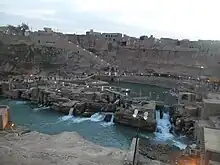Mujaz'ah ibn Thawr as-Sadusi
Mujazʾah ibn Thawr al-Sadūsī (Arabic: مجزأة بن ثور السدوسي), was a Muslim army commander and a companion of the Prophet who hailed from the clan of Sadus, a branch of the Banu Shayban tribe. Mujaz'ah was said have attended 80 military battles during his life. He died during the Siege of Shushtar (641/642), in a battle with the Sassanian commander Hormuzan, although other sources reported that he was slain during the campaign in Basra.
Mujaz'ah ibn Thawr as-Sadusi مجزأة بن ثور السدوسي | |
|---|---|
| Died | c. 641/642 Shushtar, Khuzestan Province Iran |
| Allegiance | Rashidun Caliphate |
| Service/ | Rashidun army |
| Battles/wars | |
| Relations |
|
Biography
Little is known about Mujaz'ah's early life.
Mujaz'ah participated in the Muslim conquest of Persia. Under the command of the Rashidun army, Utbah ibn Ghazwan and Arfajah ibn Harthama captured the port city al-Ubulla (Iraq). After subduing this city, Utbah was instructed by the caliph Umar ibn al-Khattab to build a permanent settlement for his soldiers. In order to accomplish this, Utbah delegated Arfajah and Mujaz'ah to construct seven tribal complexes which could fit the 700 garrison troops.[1] Then Arfajah instructed to build houses of mud bricks, plaster and mud to replace the camps.[2] When these buildings were ready, Arfajah, Mujazah, and Arfajah's fellow tribesman Hudhayfah ibn Muhsin undertook the work of attracting to the new complex members of the Azd, of the Banu Tamim, and of Mujaz'ah's own tribe, the Banu Shayban.[3]
Siege of Shushtar

Later Mujaz'ah participated, along with Arfajah, in the conquest of Khuzestan. The caliph Umar issued an order to the Rashidun commander in Iraq, Abu Musa al-Ash'ari, to head to Ahvas (Khuzestan) in order to track down the Sassanian commander Hormuzan, who had fled from Ramhormoz toward Shushtar.
After Abu Musa had besieged the city of Shustar for almost one year, someone informed him that there was a waterway under the city walls, which lead into the city. Mujaz'ah volunteered to test whether it was possible to use the waterway to infiltrate the city, by swimming through it into the city. then Majza'ah accompanying the Persian turncoat towards the underground secret passage, which he found were true.[4]
As he felt satisfied that the information given to Abu Musa was correct, Mujaz'ah returned to report to Abu Musa about how he had used the waterway to enter the city undetected.[5] Abu Musa immediately sent a small team of 35, led by al-Bara' ibn Malik and Mujaz'ah, to infiltrate the city through the waterway, and to open the city gates from the inside.[6] According to the Syrian historian Khayr al-Din al-Zirikli, Mujaz'ah and his team infiltrated though the waterway "swimming like ducks and crawling on it" before they climbed the wall.[5] When all 35 of them had entered the city, al-Bara' and Mujaz'ah immediately rushed towards the city gate, killing everyone on their way while shouting the Takbir.[6] It is said by Ibn Manda that both Mujaz'ah and al-Bara' slayed at least 100 Persian soldiers each during this battle.[7] Then, as the team had reached the gate, they immediately opened it, thus allowing the Muslim army under Abu Musa to enter the city.
The Persian garrison was routed, and many of them were slain, as Hormuzan was cornered. However, during their effort to capture Hormuzan, the Persian noble was able to kill both Mujaz'ah and al-Bara'.[7]
According to a number of other historical sources, such as Ibn Abi Hatim al-Razi, al-Bukhari, and Ibn Hibban, Mujaz'ah was killed during an earlier campaign in the area that is now known as Basra.[7]
See also
References
- Khattab, Mahmud Sheet (2010). دة فتح العراق والجزيرة [Leaders of the Conquest of Iraq and Al-Jazeera]. p. 332. Retrieved 19 November 2021.
{{cite book}}: External link in|ref= - Ibn Faqih, Ahmad ibn Muhammad. "al Buldan(countries) Part: 1 Page: 229". Library E-Shia. Retrieved 20 November 2021.
- Ibn Sa'd, Abū 'Abd Allāh Muḥammad. Tabaqat al Kubra. p. 730. Retrieved 22 November 2021.
- Ibn Taymiyyah, Taq al-Din. Yusuf Azzam, Abdullah; Qutb, Sayyid; B. al-Mehri, A. (eds.). Islamic Books by Ibn Taymiyyah Maqdisi and Abdullah Azzam. Рипол Классик. p. 368. ISBN 5872420277. Retrieved 12 December 2021.
- Zirikli, Khayr al-Din al- (2002). الأعلام : قاموس تراجم لأشهر الرجال والنساء من العرب والمستعربين والمستشرقين [Eminent Personalities: A Biographical Dictionary of Noted Men and Women among the Arabs, the Arabists and the Orientalists (Al-Aʻlām: Qāmūs Tarājim li-Ashhar al-Rijāl wa-al-Nisāʼ min al-ʻArab wa-al-Mustaʻribīn wa-al-Mustashriqīn)] (5th ed.). p. 279. Retrieved 24 November 2021.
- Ad-Dhahabi, Shams ad-Din. Siyar A'lam Nubala - Hashim ibn Utbah chapter 3 (3rd ed.). p. 200. Retrieved 24 November 2021.
- Hawramani, Ikram. "مجزاة بن ثور السدوسي". Hadith Transmitter Encyclopedia. © 2021 Hawramani.com. Retrieved 24 November 2021.